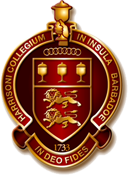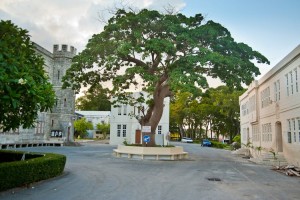History of Harrison College
We extend special thanks to Mr. Ralph Jemmott, SCM, for his kind permission to use information from his article in the 250th Commemorative edition of the Harrisonian, and from his book: “A History of Harrison College: A study of an elite educational institution in a colonial polity.”
“Every Harrisonian thinks of the School as he knew it and looks at it through his own eyes. He remembers his own experiences, his own particular friends, the other boys of his time, the Masters, the Porter, his successes and failures, his achievements or otherwise in Games and Sports, his contacts with the Headmaster, and so forth. In other words, he covers the bones of the outlines with the flesh of his own experiences.” – Harold Noad Haskell, OBE, MA, Headmaster of Harrison College, 1923-1948.
The Original Foundation 1733-1871
Thomas Harrison (1689 – 1746) was the Churchwarden of the Vestry of St. Michael. On his appointment to the position in 1729, he suggested to the Vestry that from his Churchwarden’s commission of 10% for the collecting an paying of taxes, he would subscribe a part to the establishment of a Charity School, the maintenance of which would be dependent on the benevolence of persons interested in the education and development of the country.
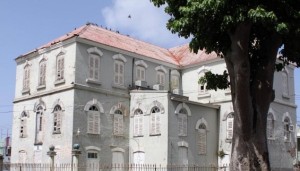 The school building, which now houses the Masonic Lodge in Spry Street, was completed in 1732. Official incorporation occurred with a Deed of July 30, 1733 with two fellow Vestrymen, Messrs John Surland and Thomas Withers acting as trustees. Additional funding came from a grant under the will of a Col. Henry Hawley, and the Church Wardens who succeeded Mr. Harrison agreed to pay 4% of their 10% commission towards the burden of administering the School. Unfortunately, in 1748, Thomas Harrison’s son, who became the new Church Warden, agreed to collect the taxes without a commission, thus depriving the School of considerable revenue.
The school building, which now houses the Masonic Lodge in Spry Street, was completed in 1732. Official incorporation occurred with a Deed of July 30, 1733 with two fellow Vestrymen, Messrs John Surland and Thomas Withers acting as trustees. Additional funding came from a grant under the will of a Col. Henry Hawley, and the Church Wardens who succeeded Mr. Harrison agreed to pay 4% of their 10% commission towards the burden of administering the School. Unfortunately, in 1748, Thomas Harrison’s son, who became the new Church Warden, agreed to collect the taxes without a commission, thus depriving the School of considerable revenue.
The School was modelled on the paradigm of the large Public School in England complete with a Governing Body which included the President of the Council, the Speaker of the House of Assembly, the Attorney-General, the Rector of the St. Michael Parish, the Churchwarden and two members of the St. Michael’s Vestry.
The school building was destroyed in the disastrous hurricane of 1780, but rebuilt with a grant from in fund in England. It ws damaged again in the hurricane of 1831, but this time the damage was less severe.
The first Headmaster, Mr. Thomas Wharton, was allowed to supplement his meagre income £20 per year, by tutoring private pupils. There is not much information about the headmasters after him, except one Mr. William Lauder (1754-1762) who had been a discredited scholar in England, and was summarily dismissed from his post at the Free School after it was discovered that he had never taught a single scholar. This same Lauder is reputed to have been the father of Rachel Lauder, known to folklorists as wealthy business woman, Rachel Pringle Polgreen.
There is not a lot of information about the functioning of the school, but there seem to have been two types of students, the “Foundation Scholars” who were provided with a free education, and “Ordinary Scholars” who were maintained ‘at their own costs’. Most of the paying students seem to have boarded with the masters or approved families in the neighbourhood. All students were “subject in all respects to the rules of discipline prescribed for the school and to have every advantage which the establishment affords.”
By 1832, the school would begin its academic year in early October and end in late July with fortnightly breaks at Christmas and Easter. The curriculum included Classics, English Composition, French, History, Geography, Writing and Arithmetic. Fee paying students paid £15 per term.
The Permanent Foundation: 1875 to 1905
By the 1860s the limited physical space began to prove inadequate. A growing number of white and coloured upper and middle-class section of the Barbadian community was demanding higher education and there were increasing requests for the expansion of the school. In addition, the premises on Spry Street had by then become surrounded by open thoroughfares and the absence of a playground for the boys was being acutely felt.
“Such an adjunct (a playing field) is considered in the mother country to be absolutely necessary to the success of a good school for the following reasons – that it is in the playground that the manly bearing of the boys is encouraged and the master is enabled to see much of the habits and character of the boys; and that it would give a healthy tone to their training, in addition to their ‘intellectual culture’” : Preamble of Act of 18 October 1870 which provided for the reestablishment of the school.
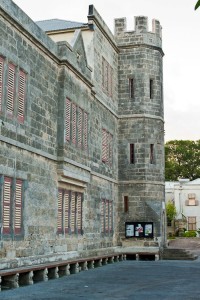 After the Act was passed by the House of Assembly, the building in Spry Street was sold and the proceeds of the sale devoted, together with a loan from the Government, towards the purchase of the Mangrove Lodge and its surroundings. The Lodge was the property of the late Thomas Crumpton and the purchase was concluded at a cost of £1,500.
After the Act was passed by the House of Assembly, the building in Spry Street was sold and the proceeds of the sale devoted, together with a loan from the Government, towards the purchase of the Mangrove Lodge and its surroundings. The Lodge was the property of the late Thomas Crumpton and the purchase was concluded at a cost of £1,500.
Management of the school, now called the new Harrison School, was entrusted to an Education Committee. The Reverend Charles Clarke was appointed Headmaster and the school opened on June 4, 1871. A press release at the time stated: “The School is intended to supply a thoroughly sound education – firstly satisfying all the requirements of pupils intended for commercial pursuits, and secondly preparing both for the English public Schools and Universities and the competitive examinations through which every department of the Public Service is now accessible. Arrangements will accordingly be made for enabling pupils to pursue whatever course of study may be suited to their special circumstances.”
The Education Committee was mandated to see that the curriculum should provide for a sound liberal education, and to further the cause of scholarship, funds were denoted to maintain a number of Foundation Scholars. Additional support came from money votes from the House of Assembly for a number of Exhibitioners. Success was not slow in coming. Harrisonians won the Gilcrhist Scholarship between 1874 and 1880 when it was replaced with the Barbados Scholarship – the Highest Award for Academic Achievement in the Island.
At that time the actual school was housed in Mangrove Lodge which is the present Headmaster’s Residence. Both upstairs and downstairs were used as classrooms. The Headmaster himself, along with some boarders, lived a little distance away at “Kent”. In 1875 the “Big School” Building (which now houses the Bell Tower) was opened, and in 1879 the Main Building with its spiral staircase was erected. In 1905 when the British military garrison left Barbados, the building now known as the Retreat was handed over to the College thus affording an entrance by the Crumpton Street gate. This building immediately became the Masters’ quarters.
Much of the stability, growth and achievement of the College during that period has been attributed to the work of Mr. Horace Deighton, Headmaster for thirty three years from 1872 to 1905. An expert Mathematician, he was an excellent teacher and competent administrator. He retired at age 75.
The War Years and Scholastic Excellence: 1906 – 1947
Succeeding Mr. Deighton as Headmaster was the Rev. Dr. Herbert Dalton who led the school until 1922. Dr. Dalton substituted Spanish for German in the curriculum, introduced the Oxford and Cambridge Higher Certificate in the 6th Form, insisted on the wearing of the School Colours, and inaugurated the Inter-School Athletic Sports. It was he, also, who divided the school into Houses or Sets in 1910:
- A:.Armstrong named after George Leslie Armstrong who had left £15,000 in his will for the Armstrong Scholarship for less well off boys.
- B: Deighton after the Headmaster Mr. Horace Deighton.
- C: Collymore after Mr. F.A. Collymore who left a bequest in his will to endow a Science Schoarship and several Exhibitions
- D: Dalton named after Mr. Dalton himself.
(After 1943 House E: Greenidge and F: Cox were introduced, but these were later abolished. These were named after Dr Abel Greenidge, historian and Mr. Arthur Somers Cox, Headmaster from 192201923 and a well-known sports personality.)
Various structures were added to the grounds during the war years.
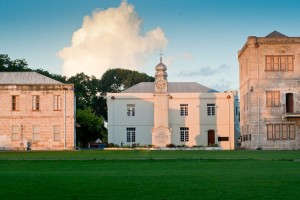 The Harrison College War Memorial commemorates the 27 Harrisonians who lost their lives in World War I. The idea for this Memorial arose after Queens Royal College in Trinidad received a tower and clock with Westminster chimes. A call was made for wealthy Harrisonians to follow suit and a Committee was formed. It was noted that 200 students had served in various capacity during the War, and a remarkable number of these with distinction, and it was agreed that a tablet would commemorate those who had fallen.
The Harrison College War Memorial commemorates the 27 Harrisonians who lost their lives in World War I. The idea for this Memorial arose after Queens Royal College in Trinidad received a tower and clock with Westminster chimes. A call was made for wealthy Harrisonians to follow suit and a Committee was formed. It was noted that 200 students had served in various capacity during the War, and a remarkable number of these with distinction, and it was agreed that a tablet would commemorate those who had fallen.
Part of the project included plans to build a School Hall to accommodate 500 students, but this had to be abandoned in 1922 because subscriptions had “not flowed with the freedom that might have been expected”.
Mr. EC Jackman donated the clock in memory of his brother Mr. JA Jackman, the Barbados Scholar of 1880 and for some time a master at the College. The Memorial was dedicated by His Lordship the Rt. Rev. Bishop Berkley, Harrisonian, first locally elected Bishop and member of the School’s Governing Body. This dedication must have been especially poignant as his own eldest son’s name was on the list.
In 1933, the Bicentenary of the School, a Building Fund was commenced which was used to construct the Belfry. The bell was donated by Mrs. Emtage in memory of her late husband Mr. O. deC. Emtage, Harrisonian, Barbados Scholar, Master of the School and later Headmaster of the Lodge School. Mr. Harold Noad Haskell was appointed Headmaster in 1923 and served through the turmoil of the Second World War, retiring in 1948 after thirty-eight years of association with the School. The School Hall was eventually completed and formally opened on March 23, 1942, 75 years after the reopening of the School at its present site. That year, Speech Day was held there for the first time, a move from the Carnegie Library on Coleridge Street, and Queen’s Park House.
Although it is scarcely worth mentioning, it was also in 1942 that the School acquired a neighbour, hardly a rival, when the New Combermere School was built at Weymouth. Of more significance, that year Barbados was attacked by a German submarine which fired a number of torpedoes into Carlisle Bay. Three Harrisonians managed to salvage one which included a propeller. This was proudly displayed to the School at Speech Day 1943. The propellor is now on permanent display in the Old Harrisonian Lounge. The College took part in the civil defence scheme for the island, with cadets assisting the Volunteer Force and schouts assisting the St. John’s Ambulance Brigade. Many Harrisonians, such as the young Errol Barrow, served with distinction during WWII. Eighteen gave their lives and are commemorated on the Memorial.
During these years, Harrison College also produced a number of great sportsmen, such as Sir Harold Austin, Captain of the West Indies Cricket Team on tours of England from 1906 to 1923 and Speaker of the House of Assembly from 1934 to 1942. Other sportsmen were Mr. George Challenor, Sir Pelham Warner, Mr. CB Williams, Mr. Cammie Smith and Mr. Clyde Walcott, one of the world famous 3Ws.
Professor D’Albuquerque, Island Professor of Chemistry and Agricultural Science established the Science Department during his 18 year tenure at the School – 1910 to 1928. He refurbished and quipped, sometimes at his own expense, a number of excellent laboratories, and insisted on the provision of a new science lecturer. However, the School continued to focus its energies on the Classics during this period, perhaps because Dr. Dalton was a Classic Scholar himself and a firm believer in the virtues of a classical education. In his biography of Sir Grantley Adams, FA Hoyos recalls his teacher Arthur Somers Cocks advising him to read one hundred lines of Homer each morning before beginning the day. Other notable classics teachers were Mr. WHL Medford and Mr. WE Isaac. Mr. John Hammond’s tenure as Headmaster, from 1949 to 1965 saw the expansion of the school with the inclusion of Modern Studies in the Sixth Form (largely the work of Dr. Bruce Hamilton), and the expansion of the number of Barbados Scholarships from one to four. As well, additional classrooms and laboratories were built, and the bench around the sandbox tree.
Student groups flourished during that time such as the Action Club, Glee Club, boxing Club and Drama Group. Members included Edward Kamau Brathwaite, Austin Clarke, Henry de B. Forde, CLO Alleyne, PC Roach and JAA Corbin. In 1951 the School chalked up its 14th win (seventh consecutive win) in the Inter-School Athletic Championship. Several Harrisonians were granted West Indian caps in cricket including Robin Bynoe, David Holford, Richard Edwards and Geoffrey Greenidge.
Mr. Hammond was followed by Mr. Albert “Tank” Williams, first local Headmaster who led the School through Barbados’ Independence Celebrations in 1966. Mr. Williams was a Mathematician and the Sciences and Mathematics began to dominate the School during that time. The adjoining Government Agricultural Complex was acquired and converted into new first forms, a Biology Laboratory, two Art rooms and Geography and Language rooms. While girls had previously attended various classes at the School and had been admitted into the Sixth Form, in 1980 the first group of girls was admitted to the first form. Mr. Williams retired in 1982 and was followed by Mr. Warren Thorpe, Mr. Clarrie Layne (1988), Dr. Robert Belgrave (1993) and the current Headmaster, Mr. Winston Crichlow (2004).
(Special thanks to Mr. Leslie St. John at www.lesliestjohn.com for his permission to use the photos of the school. Thanks also to Mr. Doug Newsam for permission to use his photo of the Masonic Lodge.)
